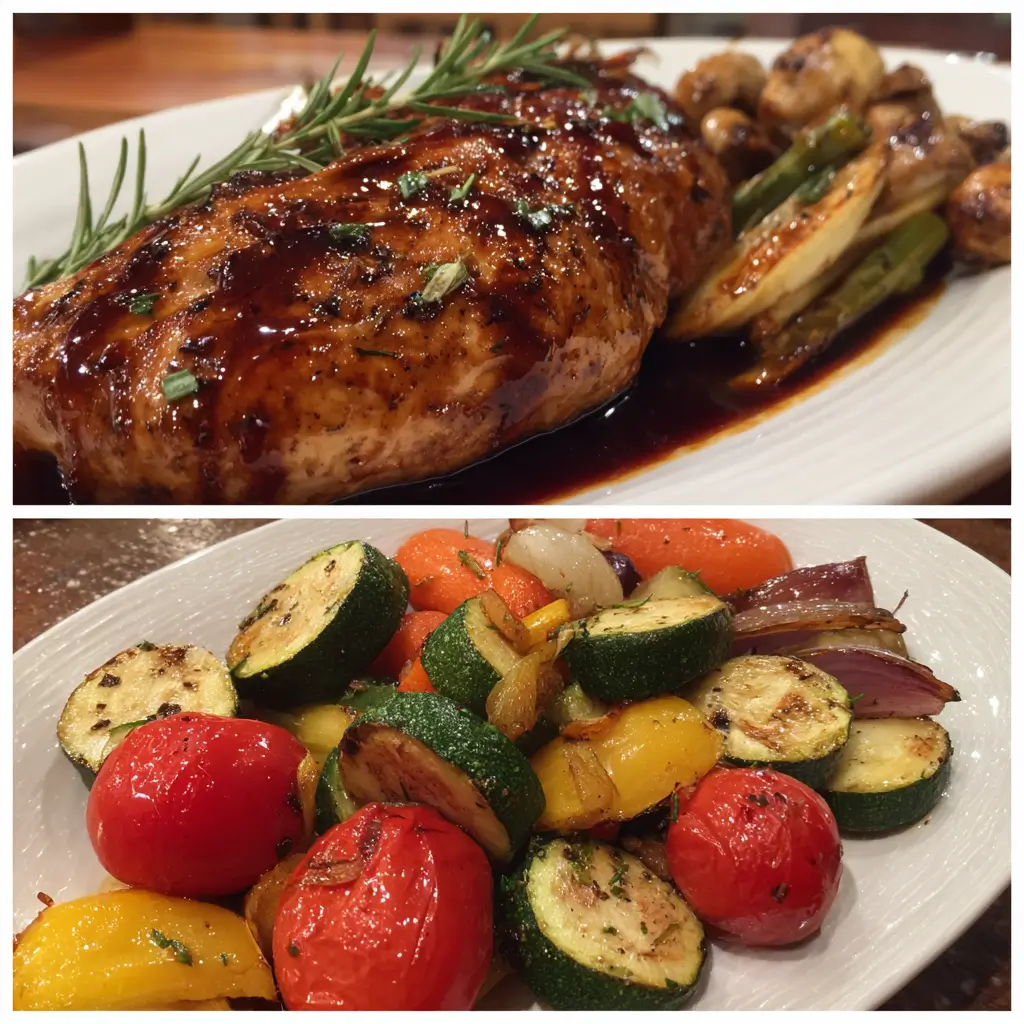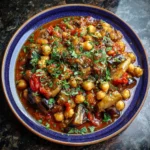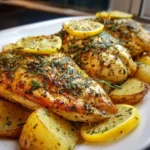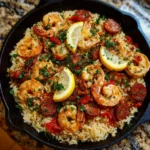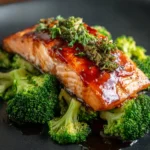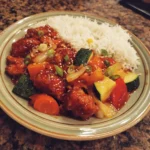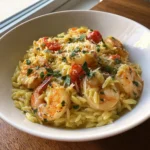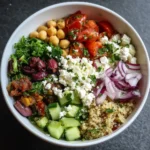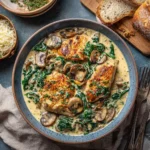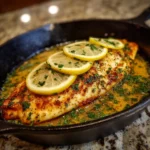Balsamic Glazed Chicken with Roasted Veggies
Balsamic Glazed Chicken with Roasted Veggies is a wholesome, flavorful, and nutritious dish that combines tender chicken breasts with a rich, tangy balsamic glaze and an assortment of colorful roasted vegetables. Perfect for weeknight dinners or elegant enough to serve guests, this meal brings together bold Mediterranean flavors with minimal effort. The natural sweetness of the roasted veggies complements the deep, slightly acidic notes of the balsamic reduction, creating a harmonious balance that delights the palate. Whether you’re a seasoned home cook or just starting your culinary journey, this recipe is simple to follow, versatile in customization, and packed with health benefits.
The History
While the exact origins of Balsamic Glazed Chicken are difficult to pinpoint, the roots of its key ingredients—balsamic vinegar and olive oil—stretch back centuries through Italian culinary tradition. True balsamic vinegar originated in Modena, Italy, where it was crafted from reduced grape must and aged for years in wooden barrels to develop its complex sweet-tart flavor. Over time, chefs and home cooks alike began incorporating balsamic vinegar into marinades, dressings, and glazes due to its depth and versatility. The concept of pairing glazed proteins with roasted vegetables gained popularity in the late 20th century as part of the farm-to-table movement and the growing emphasis on fresh, whole-food meals. Today, Balsamic Glazed Chicken with Roasted Veggies stands as a modern classic—a fusion of old-world ingredients and contemporary cooking techniques that celebrate simplicity and flavor.
Ingredients Breakdown
The magic of this dish lies in the quality and synergy of its ingredients. Here’s a detailed look at what goes into each component:
- Chicken Breasts: Boneless, skinless chicken breasts are ideal for their lean protein content and mild flavor, which readily absorbs the balsamic glaze.
- Balsamic Vinegar: A high-quality balsamic adds a balanced acidity and subtle sweetness. Opt for authentic aged balsamic if possible, but a good commercial variety works well too.
- Olive Oil: Extra virgin olive oil provides richness, aids in roasting, and enhances the absorption of fat-soluble vitamins from the vegetables.
- Garlic: Fresh minced garlic delivers a pungent, aromatic base note that elevates both the chicken and veggies.
- Honey or Maple Syrup: A touch of natural sweetener balances the acidity of the vinegar and helps form a glossy, caramelized glaze.
- Dijon Mustard: Adds depth and emulsifies the glaze while contributing a slight tang.
- Fresh Herbs: Thyme, rosemary, or oregano lend earthy, aromatic complexity. Fresh herbs are preferred, but dried work in a pinch.
- Vegetables: A medley typically includes bell peppers (red, yellow, orange), zucchini, red onion, cherry tomatoes, and broccoli. These provide color, texture, fiber, and a wide range of nutrients.
- Salt & Black Pepper: Essential seasonings that enhance all other flavors.
- Optional Additions: Crumbled feta, toasted pine nuts, or fresh basil can be added before serving for extra flair.
Step-by-Step Recipe
- Preheat Oven: Begin by preheating your oven to 400°F (200°C). This ensures even roasting and proper caramelization of the vegetables and chicken.
- Prepare Vegetables: Wash and chop all vegetables into uniform bite-sized pieces to ensure even cooking. Toss them in a large bowl with olive oil, minced garlic, salt, pepper, and your choice of herbs (such as thyme or rosemary). Spread evenly on a large parchment-lined baking sheet.
- Marinate Chicken: While the veggies roast, prepare the chicken. In a bowl, whisk together 1/3 cup balsamic vinegar, 2 tablespoons olive oil, 1 tablespoon honey (or maple syrup), 1 tablespoon Dijon mustard, 2 minced garlic cloves, and a pinch of salt and pepper. Place chicken breasts in a resealable bag or shallow dish and pour the glaze over them. Let marinate for at least 20–30 minutes (or up to 4 hours in the fridge for deeper flavor).
- Roast Vegetables First: Place the prepared vegetables in the preheated oven and roast for 15 minutes. This head start prevents them from becoming soggy when the chicken is added.
- Add Chicken to Pan: After 15 minutes, remove the pan from the oven and push the veggies to the sides. Place the marinated chicken breasts in the center. Discard excess marinade or reserve a small portion to reduce separately for basting.
- Glaze and Bake: Spoon some of the reserved glaze over the chicken. Return the pan to the oven and bake for 20–25 minutes, or until the chicken reaches an internal temperature of 165°F (74°C) and the vegetables are tender and lightly charred.
- Create a Reduction (Optional): While the chicken cooks, pour any leftover marinade into a small saucepan. Simmer over medium heat for 5–7 minutes until thickened into a syrupy glaze. This can be drizzled over the finished dish for extra shine and flavor.
- Rest and Serve: Remove the chicken from the oven and let it rest for 5 minutes. This allows juices to redistribute, ensuring moist meat. Slice if desired, then serve atop or alongside the roasted vegetables. Drizzle with additional balsamic reduction and garnish with fresh herbs.
Tips
- Uniform Cutting: Cut vegetables into similar sizes so they cook evenly. Larger root vegetables like carrots may need slightly smaller cuts than softer ones like zucchini.
- Don’t Overcrowd the Pan: Use two baking sheets if necessary. Overlapping vegetables steam instead of roast, leading to a mushy texture.
- Use Parchment Paper: It prevents sticking, makes cleanup easier, and avoids unwanted charring from metal pans.
- Marinate Longer for More Flavor: Even an hour of marinating significantly improves taste. For best results, marinate overnight.
- Baste Midway: During the last 10 minutes of cooking, brush the chicken with the warm balsamic reduction to deepen color and flavor.
- Check Doneness Properly: Use a meat thermometer to ensure chicken reaches 165°F internally without overcooking.
- Let Chicken Rest: Skipping this step can result in dry chicken. Resting locks in moisture.
- High-Quality Vinegar Matters: Avoid very cheap balsamic vinegars, which can be overly acidic or contain added sugars. Taste it first—it should be balanced.
Variations and Customizations
This recipe is highly adaptable to suit different tastes, dietary needs, and seasonal availability:
- Protein Swaps: Replace chicken with boneless thighs, pork tenderloin, salmon fillets, or tofu for a vegetarian option.
- Low-Sugar Version: Omit honey and use a sugar-free balsamic vinegar or substitute with a splash of apple cider vinegar and a pinch of stevia.
- Keto-Friendly: Use erythritol or monk fruit sweetener instead of honey and focus on low-carb veggies like cauliflower, asparagus, and mushrooms.
- Spicy Kick: Add red pepper flakes to the glaze or sprinkle with chili oil before serving.
- Citrus Twist: Add orange or lemon zest to the marinade for a bright, fresh note.
- Mediterranean Style: Add kalamata olives, artichoke hearts, and top with crumbled feta and fresh parsley.
- Asian Fusion: Swap balsamic for a mix of soy sauce, rice vinegar, ginger, and a touch of honey for a teriyaki-inspired twist.
- Root Vegetable Roast: In colder months, use sweet potatoes, parsnips, carrots, and beets for a heartier version.
- One-Pan Option: Cook everything together from the start, placing chicken on top of veggies to absorb flavors (adjust cooking time accordingly).
- Grilled Version: Instead of roasting, grill the marinated chicken and use a grill basket for the vegetables for a smoky finish.
Health Considerations and Nutritional Value
Balsamic Glazed Chicken with Roasted Veggies is not only delicious but also nutritionally balanced. Here’s why it’s a smart choice for health-conscious eaters:
- Lean Protein: Chicken breast is low in saturated fat and high in protein, supporting muscle maintenance and satiety.
- Heart-Healthy Fats: Olive oil contains monounsaturated fats and antioxidants linked to reduced inflammation and improved cardiovascular health.
- Rich in Fiber: The variety of vegetables provides dietary fiber, promoting digestive health and helping regulate blood sugar levels.
- Vitamins & Minerals: Bell peppers offer vitamin C, broccoli provides vitamin K and folate, while tomatoes contribute lycopene—an antioxidant associated with cancer prevention.
- Balsamic Benefits: Studies suggest that moderate consumption of balsamic vinegar may help lower blood sugar and improve insulin sensitivity due to its acetic acid content.
- Low in Added Sugars (When Prepared Mindfully): By controlling the amount of honey or using alternatives, this dish can fit into diabetic or low-glycemic diets.
- Antioxidant-Rich: Garlic, herbs, and colorful vegetables deliver polyphenols and flavonoids that combat oxidative stress.
- Gluten-Free & Dairy-Free (Naturally): This recipe is inherently safe for those with gluten or lactose sensitivities, unless optional dairy toppings are added.
Nutritional Estimate (per serving, approx. 1 chicken breast + 1.5 cups veggies):
Calories: 380 | Protein: 35g | Carbohydrates: 22g (Fiber: 6g, Sugars: 12g) | Fat: 16g (Saturated: 3g) | Sodium: 450mg
Ingredients
- 4 boneless, skinless chicken breasts (about 6 oz each)
- 1/3 cup balsamic vinegar (high quality)
- 3 tablespoons extra virgin olive oil (divided)
- 1 tablespoon honey or pure maple syrup
- 1 tablespoon Dijon mustard
- 4 cloves garlic, minced (divided)
- 1 teaspoon dried thyme (or 1 tablespoon fresh)
- 1 teaspoon dried rosemary (or 1 tablespoon fresh, chopped)
- Salt and freshly ground black pepper to taste
- 2 bell peppers (red, yellow, or orange), sliced
- 2 medium zucchinis, sliced into half-moons
- 1 red onion, cut into wedges
- 1 cup cherry tomatoes
- 2 cups broccoli florets
- Optional: Fresh basil, parsley, crumbled feta, or toasted pine nuts for garnish
Directions
- Preheat oven to 400°F (200°C). Line a large baking sheet with parchment paper.
- In a small bowl, whisk together balsamic vinegar, 2 tablespoons olive oil, honey, Dijon mustard, 2 cloves minced garlic, thyme, rosemary, 1/2 teaspoon salt, and 1/4 teaspoon black pepper. Set aside 2 tablespoons for later use.
- Place chicken breasts in a shallow dish or zip-top bag. Pour the remaining glaze over them, turning to coat. Marinate at room temperature for 30 minutes, or refrigerate for up to 4 hours.
- On the prepared baking sheet, toss all chopped vegetables with 1 tablespoon olive oil, remaining 2 cloves minced garlic, 1/2 teaspoon salt, and 1/4 teaspoon pepper.
- Spread vegetables in an even layer and roast for 15 minutes.
- Remove pan from oven. Push veggies to the sides and place marinated chicken breasts in the center. Discard used marinade or reserve safely for reduction.
- Return pan to oven and bake for 20–25 minutes, or until chicken reaches 165°F internally and vegetables are tender and lightly browned.
- While chicken cooks, simmer the reserved 2 tablespoons of marinade in a small saucepan over medium heat for 5–7 minutes, stirring frequently, until thickened into a syrupy glaze.
- Remove chicken and vegetables from oven. Let chicken rest 5 minutes before slicing.
- Serve chicken over or beside roasted vegetables. Drizzle with warm balsamic reduction and garnish with fresh herbs or optional toppings like feta or pine nuts.
FAQ
Can I make this ahead of time?
Yes! Marinate the chicken up to 24 hours in advance and chop the vegetables the night before. Store separately in the fridge. Assemble and roast when ready to serve.
Can I freeze leftovers?
Absolutely. Store cooled portions in airtight containers for up to 3 months. Reheat in the oven or microwave, adding a splash of water or broth to retain moisture.
Why did my balsamic glaze burn?
Balsamic vinegar with high sugar content can burn easily. Simmer on low to medium heat and stir frequently. If using a very sweet vinegar, dilute slightly with water or wine vinegar.
Can I use frozen vegetables?
Fresh is best for roasting, as frozen veggies release more moisture and may become soggy. If using frozen, thaw and pat dry thoroughly before roasting.
Is balsamic vinegar healthy?
In moderation, yes. It contains antioxidants and may support blood sugar control. However, some commercial brands add sugar or caramel coloring, so read labels carefully.
What sides go well with this dish?
Serve with quinoa, farro, couscous, mashed potatoes, or a simple arugula salad with lemon vinaigrette.
Can I make this in an air fryer?
Yes. Cook chicken in the air fryer at 375°F for 12–15 minutes, flipping halfway and basting with glaze. Roast veggies separately or in batches depending on basket size.
Summary
Balsamic Glazed Chicken with Roasted Veggies is a vibrant, nutrient-dense meal that combines succulent chicken in a rich, tangy glaze with a rainbow of perfectly roasted seasonal vegetables. Easy to customize, packed with flavor, and suitable for various diets, it’s a go-to recipe for healthy, satisfying dinners all year round.
